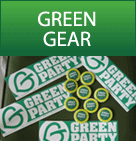Transportation
The Green Party supports transportation policies that emphasize using clean-energy mass transit and alternatives to vehicles that use fossil or other polluting fuels.
Personal electric cars are far less efficient per rider than electric mass transit and rail. A universal transition of all personal vehicles using fossil fuels to electric power would require dramatically higher emissions, prohibitive expenses and long lead times to manufacture and build an expansive recharging infrastructure when compared to building and expanding the far more efficient clean-energy mass transit and rail.
In addition, the mining of lithium, cobalt. and other materials that would be required for such a transition presents unacceptable environmental, human rights, and social justice impacts including the use of slave labor in the mining industry of the Democratic Republic of the Congo. Therefore, attempting a one to-one replacement of all fossil fuel cars with electric cars would dangerously delay efforts to reach zero emissions.
While Ride Hail services such as Uber and Lyft (also known as Transportation Network Companies or TNCs) and driverless or autonomous vehicles claim to provide increased efficiencies in actual use they contrarily present serious economic, environmental, worker justice, and public safety drawbacks. Ride Hail services in urban centers increase vehicle use, traffic congestion, and greenhouse gas emissions. Further, they dramatically reduce public transit ridership and revenues and have serious negative economic impacts on both taxi drivers and gig workers driving Ride Hail vehicles (most of whom are low-paid flex workers who are not unionized). Driverless vehicles, while relatively new to transportation, are expected to have similar traffic and environmental impacts and pose a serious economic threat to workers who make their living as drivers.
The Green Party of California advocates that Ride Hails, driverless vehicles, shuttles, and taxis be integrated into a municipal and regional government transit systems to ensure they do not detract from transit ridership and are only used where absolutely needed.
California needs transportation systems that minimize pollution and maximize energy efficiency [See the Energy, Climate & Community Resilience plank]. Transportation is responsible for a large portion of California's greenhouse gas emissions, and the vast majority of smog-forming pollution and toxic diesel emissions. Automobiles constitute a significant segment of these emissions, as the number of fossil-fueled cars in California continues to increase. After Governor Gavin Newsom announced the phase-out of gasoline-powered cars in 2020 to help fight the climate crisis, the California Air Resources Board voted in 2022 to require that 35% of new cars be zero emission by 2026, 68% by 2030, and 100% by 2035. However, this automobile-centered strategy will not meet the state’s emission reduction goals.
Our focus must shift to an equitable, clean and comprehensive mass transit strategy, making communities more bikeable and walkable, and ensuring that all modes of transportation achieve zero emissions by 2030. This holistic approach mitigates much of the negative impacts by our current ecologically irresponsible transportation systems including air, water and wetlands pollution, acid rain, heat Island effect, and others.
Massive subsidies to the auto and fossil fuel industries, as well as inefficient urban planning, maintain the automobile’s dominance of our cityscapes. The practice of widening streets and highways to relieve traffic congestion has detrimentally increased traffic by making access easier while encouraging people to work further from their homes or purchase homes further from their jobs. As some public transit riders shift to personal vehicles public transit loses funding, service deteriorates, even more people use cars, and the cycle continues.
The Green Party advocates the following:
Walkability, Bike-ability & Human Powered Individual Personal Wheeled Vehicles
1. Redesign urban communities, streets, neighborhoods, and commercial districts to be more pedestrian-oriented with shopping and workplaces as close as possible to where people live.
2. Create small, local, walkable auto-free zones, and increase the greenery on streets to encourage people to get out of their vehicles, and to help reduce the heat-island effect.
3. Implement user-friendly, traffic-calming methods in local streets’ design to promote safe speeds and safe interaction with pedestrians as described by the “Complete Streets” concept.
4. Develop extensive networks of sufficiently spaced, designated lanes and paths for personal human-powered wheeled vehicles such as bicycles, scooters, skateboards, roller-skates, and powered “adaptive devices” used by people with disabilities. These lanes can also be beneficial in case of municipal and regional declared emergencies.
5. Provide racks on all public transit and offer racks and adequate secure storage at all transit stations and other public destinations for personal human-powered wheeled vehicles.
6. Provide free personal human-powered wheeled vehicles and their necessary support services for visitors and residents so they can ride around town pollution-free.
7. Reduce the heat-island effect by using lighter pavement slurries to reflect more and absorb less sun light.
Mass Transit
8. Redirect resources and subsidies that currently go to enhancing automobile road capacity, driving, automobile commuting, and fossil fuels and their infrastructure into expanding mass transit, rail, and high-speed rail options, that serve the greatest number of people at the lowest financial and environmental costs.
9. Prioritize transit improvements to be made first in economically, environmentally and transit neglected communities which are underserved and subject to environmental injustice such as disproportionate exposure to freeways and semi-truck transportation.
10. Develop affordable, flexible, connected, and accessible municipal and regional mass transit systems using progressive state and local taxation, and to phase out all fees for free transit by 2035. Until this is achieved, encourage employer subsidies of transit commuter vouchers for employees, and mandate it for large employers.
11. Use fossil fuel-free, non-petroleum-powered efficient buses, trolleys, and rail, since the opportunity for electric transit is available, low cost, and can fulfill almost all transportation needs.
12. Increase the share of transit costs paid by developers at the time of new development, based on their anticipated impact on those costs, including street traffic and environmental impacts.
13. Use existing auto infrastructure for transit expansion where possible. For example, light rail or Bus Rapid Transit can utilize expressway medians through metropolitan high-density corridors.
14. Include transit, walkability and bike-ability requirements in land use decisions to maximize mass transit viability and use, especially for people commuting in and out of cities. [see Urban Land Use plank.]
15. Provide easy-to-understand and thorough signage and information concerning mass transit schedules, routes, and rates. Make this information convenient and accessible to riders in all languages spoken in the community.
16. Employ Universal Design in mass transit and all supporting infrastructure to achieve full accessibility for people with disabilities.
17. Democratically reform commissions, committees and boards that determine our local, regional and state transit policy and spending priorities, making them elected public bodies whose members reflect the diverse range of people being served by transit.
18. Design comprehensive, wide-reaching, and universal local and regional transit systems to maximize transit and minimize car and shuttle use, with the goal of replacing most automobile use by 2035.
Automobiles
19. Ban the sale of all new fossil-fueled cars/vehicles by 2030 and prioritize replacement of personal cars (including electric cars) with mass transit and rail to the greatest extent possible.
20. Place a moratorium on street and highway widening and divert those funds to mass transit and infrastructure for serving pedestrians and personal human-powered wheeled vehicles.
21. Provide incentives and public services to support not-for-profit carpools and rideshares.
22. Ban all private Ride Hail services and driverless vehicles, prohibit outsourcing of these services and incorporate Ride Hails, driverless vehicles, shuttles, and taxis into municipal and regional government transit systems. Drivers, security, maintenance and other workers should be government employees with union pay and benefits. Private Ride hail apps can and should be replaced with public apps for centralized municipal dispatch of drivers.
23. Remove all authority of the California Public Utilities Commission (CPUC) over municipal and regional transportation and transfer that authority to municipal and regional government transit systems.
24. Progressively reduce unnecessary auto use by limiting and eventually phasing out free parking in all areas well served by mass transit. Increase fees on parking (but offer compensation for low-income drivers), as mass transit is expanded to shift residents, workers, and visitors to use transit more over time. In urban areas well served by transit, eliminate parking requirements for new housing projects.
25. Substantially increase gasoline taxes but offer compensation for low-income drivers. [see Creating the Right Incentives plank.]
26. Legislate prohibitively high "gas guzzler" taxes on new vehicles that get a lower mpg than the California Air Resources Board guidelines https://enotrans.org/article/fuel-efficiencystandards-california-vs-the-... For comparison, see the Federal Guidelines at:
https://www.nhtsa.gov/sites/nhtsa.gov/files/2022-04/Final-Rule-Preamble_.... See Tables V-7 through V-12 for the current Federal goals to 2029 in this link.
27. Schedule yearly increases of at least 5 mpg in Corporate Average Fuel Economy (CAFE) standards for cars and light trucks.
Long Distance Travel
28. Legislate reductions in aircraft noise and air pollution.
29. Where high-speed rail is not available, make airports accessible by local transit systems.
30. Support alternatives to aircraft and truck for freight transportation such as electric-powered rail (light, heavy, and high speed), zero emissions ocean shipping, and airships (blimps, zeppelins).
31. Build high-speed rail systems between cities as alternatives to traveling by aircraft, electric or fossil fuel-powered vehicles, especially over highly traveled routes.
32. Transition to zero emissions renewable powered ships and boats by 2045
33. Do not exempt military, police, national guard, Coast Guard or other government vehicles from the above transportation objectives.
34. Fund research and development of technologies that aim to replace fossil, chemical, and nuclear-powered long distance and space launches due to the massive pollution and greenhouse gasses these activities generate.
35. Promote and encourage reducing air travel since besides high emissions of greenhouse gasses, jet fuel also produces nitrogen oxides, soot, water vapor, sulfate aerosols, and ozone that contribute to enhanced warming effects at altitude.
Amended and approved by the GPCA virtual General Assembly on June 29, 2024




